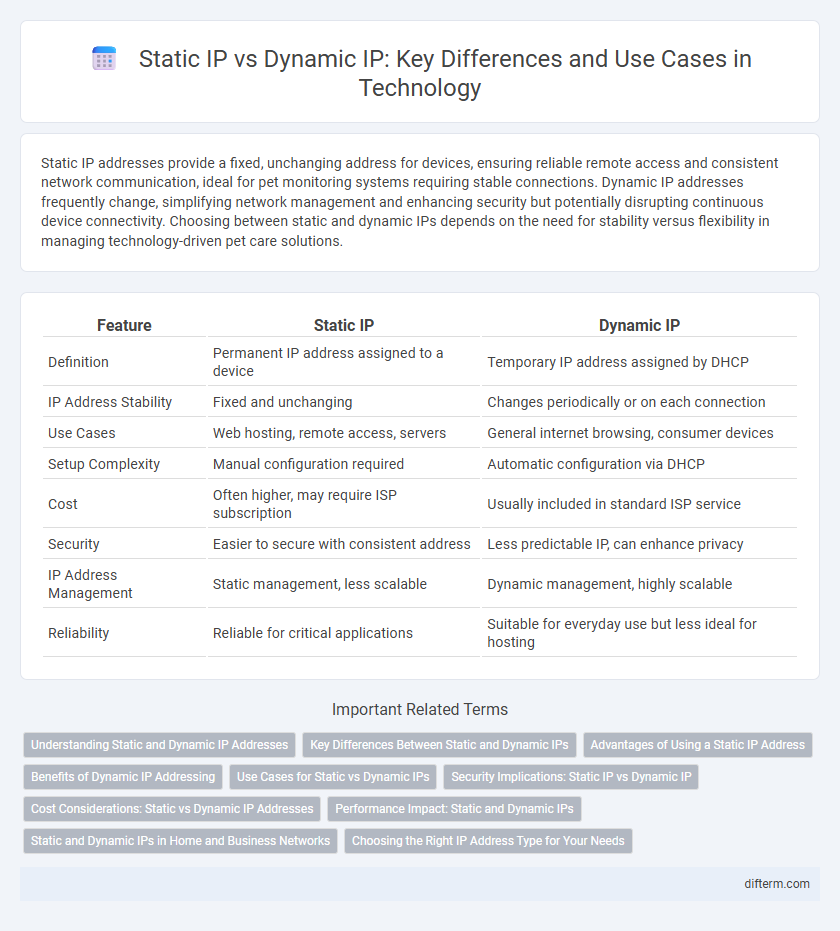Static IP addresses provide a fixed, unchanging address for devices, ensuring reliable remote access and consistent network communication, ideal for pet monitoring systems requiring stable connections. Dynamic IP addresses frequently change, simplifying network management and enhancing security but potentially disrupting continuous device connectivity. Choosing between static and dynamic IPs depends on the need for stability versus flexibility in managing technology-driven pet care solutions.
Table of Comparison
| Feature | Static IP | Dynamic IP |
|---|---|---|
| Definition | Permanent IP address assigned to a device | Temporary IP address assigned by DHCP |
| IP Address Stability | Fixed and unchanging | Changes periodically or on each connection |
| Use Cases | Web hosting, remote access, servers | General internet browsing, consumer devices |
| Setup Complexity | Manual configuration required | Automatic configuration via DHCP |
| Cost | Often higher, may require ISP subscription | Usually included in standard ISP service |
| Security | Easier to secure with consistent address | Less predictable IP, can enhance privacy |
| IP Address Management | Static management, less scalable | Dynamic management, highly scalable |
| Reliability | Reliable for critical applications | Suitable for everyday use but less ideal for hosting |
Understanding Static and Dynamic IP Addresses
Static IP addresses provide fixed numerical labels assigned to devices on a network, ensuring consistent accessibility and reliability for servers, remote access, and hosting services. Dynamic IP addresses, managed by DHCP servers, periodically change as devices connect and disconnect, offering cost-effective and flexible network management for most consumer applications. Understanding the key differences in address permanence, configuration methods, and use cases helps optimize network performance and security.
Key Differences Between Static and Dynamic IPs
Static IP addresses provide a fixed, unchanging numerical label assigned to a device, ensuring consistent accessibility crucial for hosting servers or remote access applications. Dynamic IP addresses are allocated by a DHCP server and can change periodically, offering efficient IP address management and enhanced network security through regular reassignment. Key differences include permanency, with static IPs being constant and dynamic IPs being temporary, and use cases, where static IPs suit stable connections and dynamic IPs support flexible, large-scale networks.
Advantages of Using a Static IP Address
Static IP addresses offer consistent and reliable connections crucial for hosting servers, running remote access applications, and managing network resources securely. They enable easier network management, improved DNS service reliability, and facilitate advanced configurations like port forwarding and VPN setup. This stability enhances performance for businesses requiring uninterrupted access to critical services and seamless communication across devices.
Benefits of Dynamic IP Addressing
Dynamic IP addressing enhances network efficiency by automatically assigning available IP addresses, reducing manual configuration errors and administrative overhead. This method improves security through frequent IP changes, limiting the risk of targeted cyberattacks. Additionally, dynamic IPs optimize IP address allocation in large networks, ensuring better resource management and scalability.
Use Cases for Static vs Dynamic IPs
Static IP addresses are essential for hosting servers, remote access, and running network devices requiring consistent identification, such as security cameras and VoIP systems. Dynamic IP addresses, assigned via DHCP, are ideal for general consumer internet usage, mobile devices, and environments where IP address changes do not disrupt connectivity. Businesses benefit from static IPs for VPNs and email servers, while dynamic IPs optimize resource allocation and reduce network administration complexity.
Security Implications: Static IP vs Dynamic IP
Static IP addresses offer consistent network identification, facilitating secure remote access and easier management of firewall rules, but they can become targets for cyberattacks due to their permanence. Dynamic IP addresses, frequently changing through DHCP allocation, enhance security by reducing the window of opportunity for attackers to exploit a specific IP, thus masking device identity. Enterprises often balance the stability of static IPs with the security advantages of dynamic IPs depending on their network architecture and risk tolerance.
Cost Considerations: Static vs Dynamic IP Addresses
Static IP addresses typically incur higher costs due to their permanent allocation and management requirements, making them a more expensive option for businesses needing consistent network identification. Dynamic IP addresses offer a cost-effective solution by being automatically assigned from a pool, reducing the need for manual configuration and lowering service fees. Companies prioritizing budget efficiency often prefer dynamic IPs for general use, reserving static IPs for critical servers and services requiring stable connectivity.
Performance Impact: Static and Dynamic IPs
Static IP addresses provide consistent network identification, reducing latency and improving connection reliability for applications requiring stable access, such as remote servers and VPNs. Dynamic IP addresses, assigned via DHCP, can cause slight delays during lease renewal and IP reassignment, potentially impacting real-time services or latency-sensitive activities. Network environments demanding high performance and minimal downtime often prefer static IPs to ensure predictable routing and faster response times.
Static and Dynamic IPs in Home and Business Networks
Static IP addresses provide consistent and reliable connections essential for hosting servers, remote access, and stable communication in business networks, while dynamic IPs offer flexibility and ease of management suitable for most home networks. Businesses benefit from static IPs for improved DNS support, enhanced security measures, and seamless VPN integration, whereas home users typically rely on dynamic IPs assigned by DHCP to optimize network resource allocation. Choosing between static and dynamic IPs depends on the network's operational requirements, security needs, and the scale of connected devices.
Choosing the Right IP Address Type for Your Needs
Choosing the right IP address depends on your network requirements and security needs. Static IP addresses provide consistent accessibility and are ideal for hosting servers, remote access, and network devices requiring stable connections. Dynamic IP addresses offer flexibility and efficient IP management suitable for everyday internet use, reducing the risk of IP conflicts.
static IP vs dynamic IP Infographic

 difterm.com
difterm.com